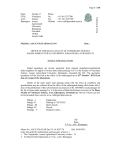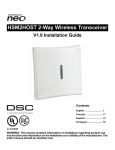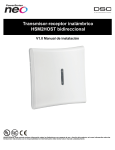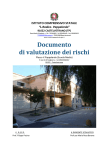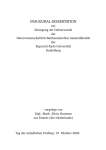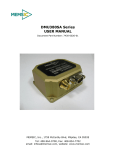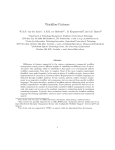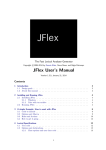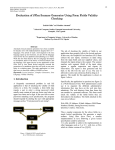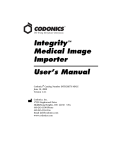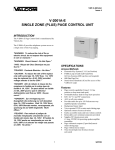Download as a PDF - University of Rhode Island
Transcript
Integration of Real-time Object-Oriented Database and Real-time
CORBA into Legacy Software
BY
QINGLI JIANG
A THESIS SUBMITTED IN PARTIAL FULFILLMENT OF THE
REQUIREMENTS FOR THE DEGREE OF
MASTER OF SCIENCE
IN
COMPUTER SCIENCE
UNIVERSITY OF RHODE ISLAND
1998
Abstract
The Joint Force Level Execution Aid (JFLEX) is military software that collects,
dispatches, processes and saves data from different organizations. All the current JFLEX
client and server software works upon the CORBA middleware, which limits the
portability of the system. Although time constraints of tasks and data are important to
JFLEX, JFLEX lacks the ability to enforce timing constraints.
In this thesis, we present a solution to enhance the portability and real-time features of
JFLEX by integrating CORBA and the real-time object-oriented paradigm into JFLEX.
The new JFLEX uses IIOP to work across different ORBs to increase its portability. A
CORBA interface has been developed to isolate the JFLEX server from the database. The
interface hides all the implementation details from the JFLEX and provides the
possibility to connect to different types of database management systems (DBMS). In
order to meet JFLEX’s real-time requirements, we used URI’s Real-time Open Objectoriented Database (Open OODB). In this project we integrated Open OODB by creating a
“wrapper” for it that facilitates its replacement.
2
Acknowledgement
I have always known that there are so many people out there who have helped me in
many ways during my struggle with the thesis. First, I would like to thank my major
advisor Dr Victor Fay-Wolfe. Without his guidance and wisdom, I would not have had a
chance to get through this interesting thesis research.
Also I would like to thank Mike Squadrito who has given me great even after he left URI
and Dr Lisa Dipippo who is so kind to help me understand her semantic locking
mechanism theory.
I wouldn’t forget to thank my teammate Yuruo Chen who has made the implementation
much easier and more enjoyable than it would have been.
Finally, I must thank my parents for their support and love throughout all these years. I
also thank my husband Jie for all his love and for comforting me whenever I was too
nervous about my problems.
3
TABLE OF CONTENTS
CHAPTER 1 INTRODUCTION .................................................................................…1
1.1 Statements of problem ..................................................................................................1
1.2 Motivation .....................................................................................................................3
1.3 Objectives .....................................................................................................................4
1.4 Thesis Outline ...........................................................................................................…4
CHAPTER 2 BACKGROUND AND RELATED WORK ...........................................6
2.1 Common Object Request Broker Architecture ........................................................….6
2.1.1 The Object Model ...........................................................................................….7
2.1.2 Interface Definition Language (IDL) ..............................................................….7
2.1.3 Object Request Broker (ORB) ........................................................................….8
2.1.4 Internet Inter-ORB Protocol (IIOP) .....................................................................9
2.1.5 CORBA Implementations ..............................................................................…10
2.2 Real-time Object-oriented Database ...........................................................................11
2.2.1 Real-time Database ............................................................................................11
2.2.2 Object-oriented Database ...................................................................................13
2.2.3 The RTSORAC Model ......................................................................................14
2.2.4 The Semantic Locking Technique .....................................................................15
2.3 Joint Force Level Execution Aid ................................................................................16
2.4 Related Team Work ....................................................................................................16
CHAPTER 3 SYSTEM REQUIREMENT, ANALYSIS AND DESIGN ..................17
3.1 The System Requirements .........................................................................................20
3.2 The System Analysis .................................................................................................21
3.3 The System Design ..........................................................................................…..…22
3.3.1 Integration Techniques ......................................................................................22
3.3.2 The New Architecture of JFLEX ......................................................................24
CHAPTER 4 THE IMPLEMENTATION ...............................................................…27
4.1 MSQL Wrapper ......................................................................................................…27
4.2 Real-time OODB Wrapper .........................................................................................32
4.3 CORBA Query Server and Query Client ..............................................................…..34
4.3.1 The Query Server IDL ...............……...........................................................…34
4.3.2 Implementation of the IDL Interface ............................................................….36
4.3.3 Providing a Server .......................................................................................…...37
4.3.4 The Query Client .........................................................................................…...38
CHAPTER 5 THE EVALUATION ......................................................................…... 39
4
5.1 Testing the Open OODB Wrapper .......................................................................….39
5.2 Testing the CORBA Query Server and Query Client ...............................................41
5.2.1 Testing the CORBA Query Server ...................................................................41
5.2.2 Testing the CORBA Query Client ....................................................................43
CHAPTER 6 CONCLUSIONS ………………………………………………………44
6.1 Thesis Summary …………………………………………………………………….44
6.2 Contributions ………………………………………………………………………..45
6.3 Future Work …………………………………………………………………………46
LIST OF REFERENCES …………………………………………………………….. 48
BIBLIOGRAPHY …………………………………………………………………….. 50
5
LIST OF TABLES
Table 5.1.1 Test Functions ………………………………………………………………42
Table 5.1.2 Query Test Suite ……………………………………………………………43
6
LIST OF FIGURES
Figure 2.1.3 ORB Structure ………………………………………………………………8
Figure 2.2.2 The Architecture of OODB ………………………………..………………14
Figure 2.3.1 The JFLEX Architecture …………………………………………………..19
Figure 2.3.2 The internal Structure of JFELX …………………………………………..21
Figure 3.3.2 RT JFLEX Architecture …………………………………………………...27
Figure 4.1 MSQL Wrapper Classes Architecture ……………………………………….31
7
CHAPTER 1
INTRODUCTION
1.1
Statement of Problem
Joint Force Level Execution Aid (JFLEX) is military software that provides a userfriendly method for monitoring the progress of a plan’s execution. One of JFLEX’s
functions is to gather objectives, activities and status information of plans from different
responsible organizations and save them into database for later processing.
The Common Object Request Broker Architecture (CORBA) is a specification of
client/server architecture provided by Object Management Group (OMG). It is an
interface that allows an application to make request of objects (servers) in a transparent,
independent manner, regardless of platform, operating system or locale considerations.
Clients interact with servers through the Object Request Broker (ORB), the central piece
of middleware in CORBA.
JFLEX was originally implemented by using CORBUS, which is a CORBA compliant
software system from BBN Inc. The General Inter-ORB Protocol (GIOP) is the OMG
protocol for ORB interoperability. It allows different ORB implementations to
communicate without restricting ORB implementation flexibility, which means a client
8
of an ORB can invoke operations on an object in a different ORB via GIOP. Internet
Inter-ORB Protocol (IIOP) is the mapping of GIOP message transfers to TCP/IP
connections.
CORBUS did not provide IIOP compliance, which means that a JFLEX
client and a JFLEX server have to work on the same CORBUS ORB.
The Database management system (DBMS) used by JFLEX is Mini SQL (MSQL), which
is a lightweight relational DBMS. Even though this database has been designed to
provide rapid access to data sets with as little system overhead as possible, it does not
suited very well to a real-time application like JFLEX due to its lack of support for
managing objects.
Object-oriented database models (OODM) are better suited for a real-time system than
relational data models. In object-oriented databases the only way to access or update the
database entities is through the methods defined on an object. So, the use of objectoriented databases allows the database concurrency control mechanism more flexibility in
granting locks based on the semantics of the individual methods of the object.
In order to improve the real-time support of JFLEX, this thesis project first converted
JFLEX from CORBUS to Orbix, which is another commercial CORBA implementation.
Since MSQL does not provide the same level of concurrency control as the real-time
Object Oriented Database (OODB), the project provided a CORBA interface that allows
replacement of MSQL by a real-time OODB that will allow JFLEX to update and process
the data in a much better way.
2
1.2
MOTIVATION
After a system is installed it has a certain lifetime and as time goes by it may not be able
to meet more and more user’s requirements. So people need to find ways to leverage their
legacy assets when designing and implementing new architectures and next generation
systems. The goal is to reuse most of the legacy system. How to get the most benefit from
it becomes a challenge.
Generally, there are two possible solutions: legacy extension and legacy integration [1].
Legacy extension modifies legacy systems without determining how the system fits into,
and contributes to, the new requirements and information architecture. Legacy extension
focuses on correcting system deficiencies and enhancing the system while addressing the
short-term requirements. On the other hand, legacy integration tries to reuse the legacy
system to implement a new architecture without propagating the weaknesses of past
design and developments methods. Integration hides legacy systems behind consistent
interfaces that hide implementation details and allows for changing or replacing
implementations without affecting other systems later on.
In this thesis, we will demonstrate that legacy integration is a good solution by applying it
to the integration of JFLEX with CORBA technology and a real-time OODB. Since
transactions are executed in a first-in-first-out manner in the old JFLEX, the transaction
with shorter deadline and higher importance that follows the transaction with longer
3
deadline and lower importance may have a chance to miss the deadline. Therefore, the
new JFLEX requires the ability to process both transactions and data with time
constraints. This introduces the need of real-time database system. We also used CORBA
to enhance the distributed ability of JFLEX and encapsulate the existing implementation.
1.3
Objectives
In this study, our primary research objective is to develop a model to integrate real-time
CORBA and real-time OODB into the existing JFLEX software to meet distributed and
real-time requirements. We will demonstrate the steps of evaluating legacy code and new
requirements and integration. Finally, we will apply it to the development of the new
JFLEX to show that legacy integration is a practical solution of reusing existing systems.
1.4
Thesis Outline
Chapter 2 describes work that is the background or related to the integration, including
CORBA, real-time OODB and related team work that is going on at the same time as this
research. Chapter 3 presents the system design of the integration. Chapter 4 describes the
implementation and integration details of JFLEX with CORBA and real-time OODB.
Chapter 5 demonstrates the performance evaluations of the new JFLEX. Chapter 6
concludes the thesis with a summary and discussion of the contributions, limitations, and
future work.
4
CHAPTER 2
BACKGROUND AND RELATED WORK
5
In this chapter, we will describe the background and work related to the design and
implementation of the integration of JFLEX. First, we will introduce CORBA. Next we
will explain the real-time OODB used for JFLEX, and show the advantages of it over
traditional related Database Management System (DBMS). We also analyze the semantic
content, usage patterns and the structure of the system. Finally, we will introduce another
related part of the JFLEX project, which is concerned with integrating real-time
scheduling into JFLEX.
2.1
Common Object Request Broker Architecture(CORBA)
OMG is an international organization supported by over 500 members, including
information system vendors, software developers and users. It creates standards for
distributed object computing that are realistic, commercially available and usable. OMG
realizes the standards through its Object Management Architecture (OMA) at the heart of
which is the CORBA. CORBA specifies the ORB technology that allows applications to
communicate with one another, no matter where they are located on a net. It defines a
framework for different ORB implementations to provide common ORB services and
interfaces to support portable clients and implementations of object [2]. CORBA also
presents new opportunities for the integration of legacy systems.
2.1.1
6
The Object Model
CORBA is based on a object model of computation. In this model, services are provided
in the context of a set of objects and requests that can be made relative to those objects.
A provider of services, a server, “contains” a set of objects and performs operations on
those objects upon requests received from clients. The server and clients are isolated by a
well-defined encapsulating interface. The definition of such interfaces is an important
part of CORBA and is the purpose of CORBA’s Interface Definition Language (IDL).
2.1.2
Interface Definition Language (IDL)
A key element of CORBA is IDL. IDL is used to describe the interfaces of service
provided by an object. The semantics of the interfaces are defined by the implementation
of the object and are not relevant to CORBA implementations. The role of a CORBA
implementation is to provide an IDL compiler and support the data transfer protocols
required to carryout object requests sent by clients.
IDL is purely a declarative language. It includes interfaces, types, operations and
modules. IDL has been defined as an independent language in order to support multiple
programming languages. Clients may invoke the functions provided by IDL without
knowing where the object is and how it is implemented. This provides an opportunity for
reusage since a CORBA interface (wrapper) can be programmed for an existing
application, to make its functionality directly accessible from other programs. For more
details about how to use IDL please read [3].
7
2.1.3
Object Request Broker (ORB)
Client
Object Implementation
Request
ORB
Figure 2.1.3 ORB Structure
The Object Request Broker (ORB) provides the mechanisms by which objects
transparently make requests and receive responses. ORB provides interoperability
between applications on different machines in heterogeneous distributed environments
and seamlessly interconnects multiple object systems. In the figure above, the client is an
entity that wishes to perform an operation defined in the IDL of the object and the object
implementation is the code and data that actually implement the object. The ORB is
responsible for all of the mechanisms required to find the object implementation for the
request, to prepare the object implementation to receive the request, and to communicate
the data making up the request. The IDL the client sees is completely independent of
where the object is located, what programming language it is implemented in, or any
other aspect which is no reflected in the object’s interface [2].
2.1.4
8
Internet Inter-ORB Protocol (IIOP)
The goal of the ORB Interoperability is to allow communications between independent
implementations of the CORBA standard, which means that it allows a client of one ORB
to invoke operations on an object in a different ORB via an agreed protocol. Thus,
invocations between client and server objects are independent of whether they are on the
same or different ORB.
The OMG protocol for ORB interoperability is called the General Inter-ORB Protocol
(GIOP). GIOP defines the on-the-wire data representation and message formats [2]; it
also makes general assumptions about the nature of the transport layer – in particular, that
it is connection-oriented. The OMG defines a specialization of GIOP that uses TCP/IP as
the transport layer. This specialization is called the Internet Inter-ORB Protocol (IIOP).
CORBA and IIOP assume the client server model of computing in which a client
program always makes requests and a server program waits to receive requests from
clients. All these communications are done through the Internet’s transport layer using
the Transmission Control Protocol (TCP).
An object accessible via IIOP is identified by an interoperable object reference (IOR). An
IOR is managed internally by the interoperating ORBs. It is not necessary for an
application programmer to know the structure of an IOR.
2.1.5
9
CORBA Implementations
In this project, we involved the following two CORBA Implementations:
• Corbus - BBN’s Corbus is a CORBA-compliant, distributed, object-oriented system
that facilitated the development of distributed applications in both local and wide area
environments. Developed by BBN under the sponsorship of the United States Air Force’s
Rome Laboratory and the Naval Command, Control and Ocean Surveillance Center
(NCCOSC) Research, Development, Test and Evaluation Division (NRaD), Corbus
specifically addressed the U.S. Military’s requirements to build and operate missioncritical information systems over globally dispersed wide area networks. But it didn’t
support IIOP in CORBA 2.0.
•Orbix – Orbix is the market leading CORBA 2.0 compliant Object Broker Request
developed by IONA Technologies PLC. Orbix supports the native Orbix protocol and
IIOP as alternative protocols. In order for clients to know about an IOR, a server must
publish that IOR. One way of publishing an IOR is to make the name of an object known
via the Naming Service. If the Naming Service is not available, servers must use some ad
hoc ways of publishing an IOR. One way is to convert the interoperable object reference
to a string and write it to a file. A client receives an IOR published by a server. For
example, by reading the string form from a file and transforms it to an Orbix reference of
the desired type and then makes invocation in a normal way.
2.2
10
Real-time Object-oriented Database (RTOODB)
Real-time applications such as JFLEX require time constraints for both the transactions
and the data that reflect the state of the application’s environment. The time constraints
for transactions mean the computations must complete before their deadline. The time
constraints for data require updating the data within a specified time interval so as to
accurately reflect the environment it represents. A traditional database system only
provides part of the functionality required by these applications, such as consistent access
to shared data. A real-time database system combines the features from both real-time
systems and database systems. The concurrency control for a real-time database must be
capable of maintaining the logical and temporal consistency of the data as well as the
transactions. In the following sections we will introduce the feature of a real-time
database, OODB (for a survey of object-oriented database research see [4]) and a realtime OODB research model developed in University of Rhode Island (URI).
2.2.1
Real-time Database
A real-time database provides data management services for applications that require
typical logical consistency as well as temporal consistency for both transaction and data.
Transaction temporal consistency constrains when each transaction must execute.
Correctness can range from requiring no support to requiring full capability of enforcing
timing constraints such as start times, deadlines, and periods on transactions.
11
Transaction logical consistency expresses how a transaction must be scheduled with
respect to accessing data objects. Transaction-based semantic correctness criteria allow
the designer to express logical correctness of a transaction schedule based on knowledge
of the specific application and of the actions performed by each transaction. These
criteria are enforced through techniques such as those that employ user-defined
compatibility sets of transactions [5]. Epsilon-serializability provides increased
concurrency by allowing each transaction to define its own limits on the amount of
inconsistency that it may view and that it may write [6].
Data temporal consistency correctness criteria can range from requiring no temporal
constraints to absolute temporal constraints to requiring absolute temporal consistency
and / or relative temporal consistency of data.
Data logical consistency is a type of consistency (data integrity) that is maintained in a
traditional database.
Unfortunately, it is difficult to satisfy all four requirements at the same time because of
the incompatibilities among them [7]. For instance, preserving temporal consistency of a
data item may require preempting a transaction that is using the data item in favor of an
update transaction. However, this preemption may violate the logical consistency of the
data item and/or the logical consistency of the preempted transaction. As a result, most
real-time database systems only guarantee soft transaction deadlines.
12
2.2.2
Object-oriented Database(OODB)
An OODB manages objects instead of tables of data as in a relational database. An
OODB is more suitable for supporting logical and temporal consistency in transactions
and data than a relational database because of the following reasons:
1) The encapsulation mechanisms of an OODB allow concurrency control specific to a
data object to be enforced within the object;
2) The capability of including user-defined operations(methods) on data objects can
improve real-time concurrency by allowing a wide range of operation granularities for
semantic real-time concurrency control;
3) An OODB potentially makes it easier to integrate constraint expression and checking
as compared to relational models.
The OODB we are going to use in this project is Open OODB. Open OODB is a
researching product from Texas Instruments that it uses Exodus to store data in files on
disks [9]. The research group at URI has converted it into a shared-memory OODB to
provide better performance. Since the data are in the main memory, the longest lifetime
of data can only be the lifetime of the operating system kernel. If the power fails, the data
will be lost. The following diagram shows the structure of this shared-memory OODB:
Real-time Operating System
Transactions
Shared address space
13
Shared Main Memory
Database
Objects
Local space
Shared address space
Local space
Shared address space
Local space
Figure 2.2.2 The Architecture of OODB
Data are saved in the shared main memory as objects. Transactions can access them as if
they were in their local address space. Any change that is made by one transaction can be
seen by other transactions.
2.2.3
The RTSORAC Model
The semantic locking concurrency control technique is based on a URI research model of
a real-time object-oriented database called RTSORAC (Real-Time Semantic Objects,
Relationships and Constraints)[9]. It extends object-oriented database models by
incorporating time into objects and transactions. Incorporating time allows for explicit
specification of data temporal consistency and transaction temporal consistency.
RTSORAC consists of a database manager, a set of object types, a set relationship type
and a set of transactions. The database manager performs typical database management
operations including scheduling of all executions on a processor, but not necessarily
including concurrency control. The database object types describe the structure of
14
database objects. The relationships specify associations between objects and are used to
define inter-object constraints. The transactions are executable entities that access the
objects and relationships in a database.
2.2.4
The Semantic Locking Technique
Typical database management systems provide concurrency control techniques that
preserve logical consistency of data items (e.g. read/write locking) and logical
consistency of transactions (e.g. two-phase locking). Although these two requirements
still exist for concurrency control techniques in real-time databases, two additional
requirements are needed to be supported: the real-time scheduling algorithm in enforcing
transaction timing constraints, and preservation of data temporal consistency constraints.
The semantic locking technique integrates support for the four real-time concurrency
control (RTCC) requirements: transaction temporal consistency, transaction logical
consistency, data temporal consistency, and data logical consistency.
Designing a concurrency control technique that meets all four forms of Real-time
Concurrency Control requirements is difficult because of the reason mentioned above.
Therefore, a concurrency control technique must be capable of expressing the tradeoffs in
sacrificing one requirement for another. These tradeoffs are application-specific. In the
semantic real-time concurrency control technique that we are going to use for JFLEX, the
Concurrency Control mechanism of each object uses semantic locking to enforce the
allowable concurrency expressed by the compatibility function of the object. A
15
transaction must acquire a semantic lock for a method invocation before the method is
allowed to execute.
2.3
Joint Force Level Execution Aid (JFLEX)
JFLEX is distributed software developed by the U.S. Navy Research Lab in San Diego,
CA (NRaD). It depicts the status of a plan by graphically organizing the plan’s
objectives, chains-of-command, activities and status information into an easy-to-read
display. A plan is composed of responsible organizations and subplans (sequences of
actions). Each responsible organization is assigned a subplan for execution. JFLEX
distributes the status information for a plan to each workstation running a JFLEX client
over a wide area TCP/IP network. It also allows clients to change and update the status of
plan activities. This allows managers to get the information of how well a plan is
succeeding. JFLEX estimates plan viability by monitoring the continued validity of the
underlying assumptions of the plan.
JFLEX consists of three main operational modules: Plan Editor, Plan Monitor, and Plan
Server. The Plan Server is a central server process. It manages a central database
containing plan-related information and provides IDL to support requests from client
processes through CORBA. The plan Editor serves as a client process that allows users to
create a plan representation consisting of plan objectives, subplans, responsible
organizations, conditions and states. The client Plan Monitor processes display the plan
information and support the user interface for monitoring plans.
16
• JFLEX Architecture
JFLEX Client
JFLEX Server
MSQL Wrapper
JFLEX DB
DB
Tables
DB
MSQL DB
Figure 2.3.1 The JFLEX Architecture
Figure 2.3.1 shows the architecture of JFLEX. A JFLEX client includes a Plan Editor and
a Plan Monitor. JFLEX Server is a Plan Server. All the data managed by JFLEX are
saved as tables in a MSQL database. The MSQL Wrapper is a C++ interface provided by
MSQL database management system. The JFLEX server manipulates the data in the
JFLEX database through the MSQL wrapper.
•
17
Internal Structure of JFLEX Server
The JFLEX server contains objects that provide CORBA IDL to the JFLEX clients.
These IDL interfaces hide all the implementation details from the clients and offer great
flexibility to reuse and update the old code. The clients make a call to objects without
knowing their locations, which means remote calls appear similar to local calls. The
CORBA ORB processes requests and returns results to the client transparently. In the
original JFLEX, the CORBA ORB is CORBUS. The JFLEX objects implementation
create and use objects in several kernel files that communicate with the MSQL wrapper.
In the Figure 3.1.2, a JFLEX client makes a request to the JFLEX server. The format of
the request is the same to the client no matter whether it is a local server or a remote one.
The underlying CORBA ORB is responsible for selecting of a JFLEX server that can
process the request and for handling the communication between the client and the
server. The kernel files layer contains objects that provide member functions to
communicate with the MSQL wrapper. The object implementation creates objects in the
kernel files layer to manipulates and maintains the data in MSQL database according to
the request from the client. Finally, the server sends the reply back to the client through
CORBA ORB.
CORBA ORB
JFLEX Objects IDL
JFLEX Objects
Implementation
Kernel Files
MSQL DB
18
JFLEX Client
MSQL Wrapper
Figure 2.3.2 The Internal Structure of JFELX
2.4
Related Team Work
CORBA is currently inadequate to support real-time requirements. For example, IDL
describes the interface to the functional behavior distributed components, but does not
explicitly describe timing constraints for their behaviors. Furthermore, system services
provided by distributed environments offer little support for end-to-end real-time
scheduling across the environments. The real-time research group at URI has extended
ORBIX to a subset of a real-time CORBA system, which provides additional services
such as real-time event service, priority server for scheduling, and extends the
concurrency control service [10].
Because of the real-time features of JFLEX, the related teamwork done by Yuruo Chen
focuses on changing it into a real-time distributed application using URI’s RT CORBA.
The new JFLEX uses a data structure (Real-time Environment) to keep the necessary
information to process a CORBA request in real-time. The RT_Manager and Pserver
developed by the RT research group at URI [10] are used to handle the real-time
environment and schedule according to the environment variable.
19
CHAPTER 3
SYSTEM DESIGN
The goal of this thesis research is to develop a practical model to integrate real-time
CORBA and real-time OODB into the legacy system JFLEX. In the system design phase,
we evaluated the old structure with new requirements. Finally, we created a high level
model that not only makes the maximum use of the old code and makes least change out
of it but also meets the new requirements.
3.1
The System Requirements
The system requirements of JFLEX fall into four categories: portability, real-time,
extensibility and isolation. We now discuss each of these requirements.
•
Portability
Since CORBUS does not support IIOP, the JFLEX server and clients have to work under
the same ORB. However, a new client that uses Orbix cannot communicate with JFLEX
objects. The new JFLEX must work across multiple ORBs, therefore we use IIOP to hide
the underlying ORB.
20
•
Real-time Features
In order to meet the deadlines of transactions and keep the consistency of data in the
database, JFLEX needs real-time scheduling to make a better effort to avoid missing
deadlines of transactions by arranging them in an more efficient way [see the related team
work section].
JFLEX also needs a real-time OODB to maintain both logical and
temporal consistency of transactions and data in the manipulation of the database.
•
Extendibility and Isolation
JFLEX should be able to use multiple database management systems instead of just a
specified one. This requires the database interface to be well designed so that it can be
easily adapted to various database management systems. Isolation requires that users can
access data through the interface without the knowledge of which database they belong
to. The implementation of the interface must process the request from the user and select
an appropriate database to do all the operations.
3.2
The System Analysis
To meet the above requirements, we first need to transport JFLEX from CORBUS to
Orbix. In the transportation, the architecture of JFLEX will remain unchanged. The
kernel files layer of JFLEX and the MSQL wrapper layer have nothing to do with the
CORBA ORB, so we can leave them unchanged.
21
To integrate a real-time a OODB into JFLEX, we seek to minimize changes to legacy
codes. The kernel files layer can only use the objects with similar interface as the MSQL
wrapper. We chose to implement the real-time OODB with a wrapper with a similar
interface to MSQL. We also ensured that the structure of the result returned from the
database is the same in both the MSQL wrapper and real-time OODB wrapper. In order
to satisfy extendibility and isolation requirements, we can use a CORBA server to deal
with the MSQL wrapper and OODB wrapper and provide a unique interface to users. At
this point, the kernel files layer becomes a client of this server that does not know which
database it reaches.
3.3
The System Design
Based on the analysis in the last section, we can follow the below steps to finish the
design of the new architecture of JFLEX.
3.3.1
Integration Techniques
Using a object wrappers is one method for bridging the new application architecture’s
abstract interface to the legacy software identified by the technical architecture. On one
side of the bridge, the wrapper presents systems with a clean, abstract interface. On the
other side, the wrapper communicates with legacy systems using their existing facilities
or other new systems. Object wrappers provide a natural way to integrate legacy systems
with new systems. Once wrapped, legacy systems can participate in the new architecture
22
with least change and have a chance to extend its system structure to meet more
requirements. At the same time, wrappers provide constant interfaces to other systems as
they do with the legacy systems. This keeps systems from being aware of implementation
changes and eliminates the need for modifying these systems.
The key benefit of using object wrappers is that they provide consistent services to both
legacy and new systems. The following are the approaches to object wrapping.
•
Layer – Layering, the most basic type of wrapping, maps one form of interface onto
another. The functions provided by layering depend on the sophistication and availability
of the legacy system’s existing interface. If a legacy system has no or minimal interface,
little can be done using layering techniques. Layering can be used to aggregate multiple
legacy systems. Conversely, layered object wrappers can partition a complex legacy
system into multiple objects.
•
Data Migration – Data migration maps the existing data model onto a different
model. Wrapping involves adding a layer that bridges the new data model and the legacy
database. Data migration wrappers change database schemes and the databases
themselves without affecting the objects that use these wrappers.
•
Middleware – Middleware is system integration software for distributed processing
and for database and user interfaces. CORBA is one kind of the middleware that can be
used to do the integration. Database middleware provides common access mechanisms
23
for using a variety of database systems and file structures. It allows a system to issue a
single information request and to access, in turn several data sources that can each be
using a different database management system.
•
Encapsulation – Encapsulation, the most general form of object wrapping, separates
interfaces from implementations. All accesses, including direct and indirect accesses, are
performed through interface methods. Using interface allows implementation details to
be changed without requiring other changes. Using CORBA and its IDL is a good
solution to encapsulate systems that hide differences in programming languages, systems
locations, operating systems, algorithms and data structures. In the context of system
architecture, wrappers translate between the architecture and legacy systems. Wrappers
should implement the architecture in all of its details, including providing metadata and
data conversions.
3.3.2
The New Architecture of JFLEX
In the new architecture of JFLEX shown in Figure 3.3.2, we selected CORBA as
database middleware for the distributed and encapsulation purpose. Thus, the CORBA
query server provides a common interface for querying data in the database, which can be
used by other systems besides JFLEX. Because of the distributed feature of CORBA, the
JFLEX objects and database do not need to reside on the same host. Since the real-time
OODB is a shared memory OODB, it has to reside on the same host as the CORBA query
server so as to retrieve the data stored in the local main memory. IDL encapsulates the
24
implementation details. So the objects above it are unaware of how the server decides
which database management system to be used. It is also convenient to extend to other
database management system independently of others.
Above the CORBA query server in Figure 3.3.2, we mapped the MSQL wrapper onto
one layer, the C++ query client, which makes use of CORBA IDL to manipulate data in
the database. We need this layer because the legacy kernel files must instruct the MSQL
wrapper. This layer serves as a CORBA client and must convert the query result sent
back by the CORBA query server into the data structure that MSQL wrapper has,
otherwise the kernel files cannot process them.
We also need to encapsulate real-time OODB since it cannot process query statements
(SQL). We added an OODB wrapper that provides basic ability to process query
statements and bridges the MSQL data structure and the OODB data. So the wrapper has
the similar interface as MSQL wrapper and it converts the query result into the data
structure of MSQL wrapper. Thus, the data structure of query result got by CORBA
query server is just the same no matter which database management system it comes
from.
Our design uses several object wrapper techniques to isolate and encapsulate the database
part of JFLEX yet to keep other parts unchanged.
25
legacy
modified legacy
JFLEX Client
original code
IIOP
JFLEX Server
C++ Query Wrapper
CORBA Query Server
OODB Wrapper
MSQL Wrapper
Real-time OODB
MSQL DB
Figure 3.3.2 RT JFLEX Architecture
26
CHAPTER 4
THE IMPLEMENTATION
In this chapter we will describe the implementation of the new JFLEX architecture based
on the design presented in Chapter 3. In the following sections, we will explain the
implementation of each part of the new architecture in full details.
4.1
MSQL Wrapper
The MSQL Wrapper consists of several C++ objects to provide functionality to access
and retrieve data in MSQL [see figure 4.1]. The MsqlDB is an important part of the
wrapper. It opens the connection from a user to a MSQL database daemon, selects a
database and sends queries to daemon. The result will be sent back in a instance of
MsqlResult which is a set of rows (tuples).
27
Class MsqlDB
{
public:
Boolean connect (string host_or_ip_addr);
//provide the name or IP address of the host running the Msql daemon. Returns true if it connects
//successfully.
void disconnect( );
//disable the connection
Boolean isConnected( );
Boolean selectDB (string db_name);
//choose a database by name
int query(string query);
int query(string query, MsqlResult &);
//use the first query if there is no result back from the database, like creating a table
//use the second query if you want an MsqlResult to be set, like select queries
//the input string should be a valid SQL statement
//returns the number of rows affected by the query or –1 unsuccessful
};
The result is returned as an instance of MsqlResult. From an MsqlResult object you can
generate objects of class MsqlRowIter, MsqlRow, MsqlFieldIter, MsqlField and finally
get raw data of the result by using MsqlField::getRawData( ).
28
class MsqlResult
{
public:
void set(m_result *);
Boolean isGood ();
MsqlRowIter getRowIter ();
int numRows( );
int numFields( );
};
If the instance of MsqlResult is valid (can be checked by using MsqlResult::isGood( )) ,
MsqlRowIter can be gotten from MsqlResult and users can use it to retrieve all rows.
Class MsqlRowIter
{
public:
//derefernce the iterator
MsqlRow & operator*();
//pre-increment the iterator
MsqlRowIter & operator++();
Boolean isGood();
};
From the instance of MsqlRowIter, users can get a instance of MsqlRow that represents a
tuple.
29
Class MsqlRow
{
public:
MsqlFieldIter getFieldIter();
Int numField( );
};
From the instance of MsqlRow, users can get a MsqlFieldIter instance that can be used to
retrieve the fields in the tuple.
Class MsqlFieldIter
{
public:
MsqlField & operator *();
MsqlField & operator++();
};
By using the instance of MsqlFieldIter, users can get a instance of MsqlField that can get
the raw data of the field. The raw data are in the format of string and users need to
convert them to the corresponding data type.
30
MSQL Wrapper User
query
MsqlDB
RawData
MsqlResult
MsqlRowIter
MsqlRow
MSQL Wrapper
MsqlFieldRow
MsqlField
MSQL DB
Figure 4.1 MSQL Wrapper Classes Architecture
Class MslqField
{
public:
string getRawData( );
};
The basic data structures that the MSQL Wrapper deals with are shown below. They save
all the information about the field and the value of the result.
31
string m_row;
//the raw data of one row
struct m_data //a link list of rows
{
m_row data;
m_data* next;
};
struct m_field
{
//field information
string field_name;
string table_name;
int field_type;
int field_length;
};
struct m_fdata //a link list of fields
{
m_field field;
m_fdata* next;
};
struct m_result //keeps the information about the rows and fields
{
m_data * query_data;
m_fdata * field_data;
int numRow;
int numFields;
};
Note that MSQL data structures and classes can represent the result and manipulate it in
a clean and efficient way. We decided to make the real-time OODB wrapper and
CORBA server IDL a similar interface as MsqlDB and store the result in the MSQL data
32
structures. By doing so, we can use the implementations of MsqlResult, MsqlRowIter and
other classes directly that allows us to access the raw data in the data structures without
rewriting the codes again. We only need to link the library of these classes into the object
file. This certainly makes the best use of the legacy asset of the MSQL wrapper and
makes our work easier.
4.2
The Real-time OODB Wrapper
The real-time OODB that we are using in this study is a shared memory database
developed at URI[11]. It provides different concurrency control options we described
before and allows users to specify the semantics for compatibility function [7] to meet
different application requirements.
This real-time shared memory OODB has very good performance compared to the
original Open OODB with concurrency control disabled [11]. It only provides basic
functionality of manipulating data stored as objects in shared memory:
• Insert one object into a list
• Delete one object from a list
• Fetch a list of objects that can be retrieved one by one.
So we need a wrapper that can accept a query statement, parse it, do the corresponding
operations on the objects and converts the result into MSQL data structures. The
33
following is the interface of OODB wrapper. It is quite similar to the interface of the
MsqlDB class.
Class OpenDB
{
public:
int connect( ); //create an OODB object and be ready to do basic operations
int isConnect( );
long query( string query);
long query(string query, MsqlResult & );
...
};
Besides the wrapper, we also need to convert the relational tables into objects in OODB.
Basically, we made one object out of one table for convenience and consistency.
The fields in a table became the private members of a object and users can access and
update the information of them through the public member functions. In the OpenDB
class, we have a private pointer point to the list of objects and we can maintain the
objects in the list through it. If we have different classes of objects, we need different
pointers. Each one points to one kind of lists of objects.
4.3
CORBA Query Server and Query Client
The CORBA query server provides IDL for general operations on different database
management systems. The Query client is used to substitute the MSQL wrapper used by the
34
kernel files layer. It offers the similar C++ interface as the MsqlDB to the kernel files layer.
In the following sections, we will demonstrate the steps of implementing this CORBA part.
4.3.1
The Query Server IDL
After we mapped the IDL of Query Server onto MsqlDB, sending the query result back to
query client remained a problem.
In the query server, we sent the query to the
corresponding database and got the result as an object of the MsqlResult class (see at
4.1). We could not send this object directly back to clients since it hadn’t been defined in
IDL and ORB could not bind the clients’ call of the object to its implementation.
Because we don’t have the source code of MsqlResult, and MsqlResult has relationships
with other classes, it is too complicated and unnecessary to define all of them in IDL and
rewrite the codes for them. Therefore, we decided to define a structure in IDL containing
all the information about the result for the clients to reassemble a MsqlResult object on
its own side. The following is the IDL:
typedef sequence<string> q_row;
struct q_field
{
string name,table;
long type,length;
};
struct q_data
{
long width;
q_row data;
35
};
typedef sequence<q_data>q_datas;
typedef sequence<q_field> q_fdata;
struct q_result
{
q_datas query_data;
q_fdata field_data;
long numRows, numFields;
};
interface QueryServer
{
boolean connect( in string host);
void disconnect ( );
boolean isConnected( );
boolean selectDB( in string db_name);
long query(in string query);
long selectquery( in string query, out q_result mresult);
};
IDL doesn’t support pointers. Instead, we map the MSQL data structures onto IDL by
using IDL sequences. The server then has to get the information out the object of
MsqlResult and assemble it into sequences and clients need to reassemble it to create a
MsqlResult object for the kernel files layer.
4.3.2
Implementation of the IDL Interface
Each IDL type will be implemented by a corresponding C++ type. For instance, interfaces
map to classes. The implementation class must implement each of the functions that
36
correspond to IDL operations and attributes. Instances of such a class are Orbix objects –
they are accessible from any code in the distributed system.
Clients are not concerned with the implementation class. They are only aware of IDL
interfaces. When a client makes a function call, the call will be sent to an instance of the
corresponding implementation class through ORB.
The implementation class of query server contains two private static pointers, one points
to an instance of MsqlDB, and the other points to an instance of OpenDB. The query
server is responsible to create these two instances and set the pointers. These two
instances will create connections to the corresponding database management system.
When a query statement comes in, the server will decide which database it should be sent
to and get the result back.
class QueryServer_i
{
private:
static MsqlDB* sDB;
static OpenDB* oDB;
...
};
37
4.3.3
Providing a Server
To keep clients and servers in different process address space, we need to provide a
server program in which a query server will run.
This server program creates a query server object and indicates to Orbix that the server’s
initialization has completed.
int main()
{
Query Server_ptr tie_query =
new TIE_QueryServer(QueryServer_i)(new QueryServer_i);
//create a query server object
CORBA:: Orbix.impl_is_ready
(“QueryServer”, CORBA::Orbix.INFINITE_TIMEOUT);
//initiate the server
...
}
4.3.4
The Query Client
A query client passes query statements from the kernel files layer to the CORBA query
server. It needs to convert the data in sequence back into the MSQL data structure.
38
class MsqlDB
{
public:
Boolean connect(string host_or_ip_addr);
void disconnect( );
Boolean isConnected( );
Boolean selectDB (string db_name);
int query(string query);
int query(string query, MsqlResult& )
...
};
We make the name of the query client just the same as MsqlDB because we only want to
substitute the implementation of the class with a new one that can make a connection to
CORBA query server. The kernel files layer can keep unchanged since the interface and
the name of the class is the same as the old ones. With the object wrapper techniques, we
isolate the database part from the JFLEX and make it a relative independent part that can
provide service to other users.
39
CHAPTER 5
THE EVALUATION
In this chapter we present three groups of tests, one for Open OODB wrapper, one for
CORBA query server and one for query client to ensure the runtime correctness of the
implementations. We had planned to bind CORBA query server to both MSQL database
and Open OODB but failed the Open OODB part. We will explain the reason in this
section.
5.1
Testing the Open OODB Wrapper
Before testing the Open OODB wrapper, we need an initial program that first initializes
the shared memory and then loads test data of objects into the shared memory. The data
are “persistent” in the shared memory as long as the kernel is running.
Next, we wrote a test program to create an instance of Open OODB wrapper and test the
member functions in it. We could bind the wrapper to the CORBA query server only
when it passes this test.
40
In the table 5.1, we list out the functions need to be tested:
int connect();
int isConnected();
long query( char * query, MsqlResult& mresult);
long query( char * query);
Table 5.1.1 Test Functions
The Connect () function is responsible for fetching several lists of objects. It must be run
before the query functions. The IsConnected () indicates if the fetching has been done or
not. The query(char * query, MsqlResult& mresult) works for select statements that
require the result to be returned back to the caller. The query (char * query) is for other
query statements, like update, insert, etc.
The initial program loads several objects in the shared memory: State, GeographicArea,
StateIndicator and StateCounterIndicator. As we mentioned in the implementation
section, we coded functions for the queries used in the JFLEX for these objects. We
selected typical queries of different operations on the data related to the object State to be
the test suite.
41
SELECT * FROM State WHERE StateID = number
SELECT * FROM State
UPDATE State SET Name =‘string’, Description=‘string’
WHERE StateID = number
INSERT INTO State VALUES (long, float, float, float, float)
DELETE FROM State WHERE StateID = number
Table 5.1.2 Query Test Suite
The test results of the above queries were correct.
5.2
Testing the CORBA Query Server and Query Client
In the new system, the CORBA Query Server provides a common interface of different
DBMSs to isolate the JFLEX from the database. To change the code of JFLEX as little as
possible, we added a query client whose interface is similar to that of MSQL wrapper to
invoke the functions in the query server. The test was done incrementally.
5.2.1
42
Testing the CORBA Query Server
First, we created a test program that binds to the query server and then tests several query
statements that process different data in the different database management systems. The
CORBA query server is expected to specify the database management system to which
the query belongs, send the query to the DBMS, get the result back and send it to the test
program.
When we tried to substitute the test program of Open OODB with the CORBA query
server so that the query server can deal with both MSQL database and Open OODB, we
failed to do so. All the source code related to the Open OODB must be compiled by a
preprocessor from Texas Instrument. The preprocessor, called ppCC, preprocesses class
definitions and extends them with member functions for use by the Open OODB[12].
The ppCC is a driver program that invokes several other programs, including the C++
preprocessor (cpp), the Open OODB C++ preprocessor (ccpp) and the C++ compiler.
Because of cpp and ccpp, the ppCC is more rigorous than the Solaris C++ compiler that
we use. The ppCC can detect errors in a program that can be compiled by the C++
compiler [12]. In our case, the ppCC failed to preprocess the source code of the CORBA
query server because ccpp complains about one of the Orbix system header files. So we
only tested the CORBA query server with the MSQL database.
We selected different types of query statements to process the data stored in MSQL
database through the CORBA query server. The test results were all correct.
43
5.2.2
Testing the CORBA Query Client
After the test above, we replaced the test program with the CORBA query client,
expecting that the JFLEX server can manipulate the data in MSQL database through the
CORBA query client and the query server. The execution steps were as following:
1. Run MSQL daemon;
2. Run Orbix daemon;
3. Register the JFLEX server and the CORBA query server to Orbix;
4. Execute a JFLEX client as we run the original JFLEX.
The result was the same as we expected - the new JFLEX system had the same
functionality as the old one and the JFLEX server was not aware of the existence of the
CORBA query client and query server layer we added.
CHAPTER 6
CONCLUSION
In this thesis research we have explored several object wrapper techniques to integrate
new functions into legacy software. Our approaches have been demonstrated in the
44
design and implementation of integrating the real-time OODB and CORBA IDL interface
into the JFLEX. In this chapter, we will summarize what we have achieved in this thesis
project, describe our research contributions, and project our future work.
6.1
Thesis Summary
In Chapter 3, we listed a set of system requirements (Table 3.1) for the new JFLEX
system. Our design and implementation presented in Chapter 3 and 4 have demonstrated
that these requirements have been mostly fulfilled:
Portability: We used the IIOP protocol for ORB interoperability. So the JFLEX client
and server could be developed upon different ORBs independently and communicate
freely.
Real-time Features: The related team work mentioned in Chapter 2 added real-time
scheduling to help transactions of the JFLEX meet deadlines better. Furthermore, we
introduced a real-time OODB to maintain the real-time consistency of transactions and
data of database, such as data temporal consistency. We were not able to make the Open
OODB work for the JFLEX because the CORBA system file could not pass the
compiling of the preprocessor of Open OODB. However, we designed wrapper
functionality to allow the integration of Open OODB and tested it independently.
45
Extendibility and Isolation: The CORBA interface of the query server we developed
isolates users from different database management systems. The CORBA query server
can be extended to work for different types of DBMSs, such as relational database and
OODB, and users can access data without the knowledge of the DBMS.
6.2
Contributions
Our research has the following contributions:
1. It explored the technology of integrating real-time OODB and real-time CORBA into
legacy software and reusing the existing source code as much as possible.
2. It developed a model to add a CORBA server to legacy software to meet more system
requirements.
3. It provides a common CORBA query interface that hides all the implementation details
of dealing with different types of DBMSs from users, which allows more flexibility to
expand the system.
4. It provides a methodology to develop a C++ wrapper for Open OODB, which also
works for other DBMSs.
5. It shows a way to convert information from relational database to OODB.
6. It shows how to convert the application from one ORB to another and make it IIOP
compliant.
46
6.3
Future Work
As described in our implementation and tests sections, the Open OODB wrapper can
process simple format of query statements from the JFLEX. Obviously, this is not
enough. We need a wrapper that can process queries as general as possible (the format of
query is in SQL set). One possible improvement is to write parser for the wrapper using
LEX and YACC that also can check the syntax of queries.
During our implementation the CORBA query server didn’t connect to the Open OODB
wrapper as designed due to the problem come from the preprocessor of the Open OODB.
One possible way to solve it is to study the parser in the cpp written by YACC so that we
can relax the syntax.
Another interesting future project is adding real-time scheduling to the CORBA query
server and client as we already did with the JFLEX server and client [see the related team
work]. This will allow the complete scheduling for transactions from JFLEX clients.
47
LIST OF REFERENCES
[1] Donald E. Rimel Jr. and Ronald C. Aronica, "Leveraging Legacy Assets", in Legacy
Integration, Dec. 1996.
[2] The Common Object Request Broker: Architecture and Specification, OMG
Document Number 93.xx.yy, Revision 1.2, Draft 29 December 1993.
[3] Orbix 2 Reference Guide, IONA Technologies PLC, March 1997.
[4] S. Zdonik and D. Maier, Reading in Object Oriented Database Systems. San Mateom
CA: Morgan Kauffman, 1990.
[5] H. Garcia-Molina, "Using semantic knowledge for transaction processing in a
distributed database system," ACM Transactions on Database Systems, vol.8,pp. 186213, June 1983.
48
[6] K. Ramamritham and C. Pu, "A formal characterization of epsilon serializability,"
Transactions on Knowledge and Data Engineering.
[7] L. Dipippo and V. F. Wolfe, "Object-based semantic real-time concurrency control",
in Proc. of IEEE Real-Time System Symposium, December 1993.
[8] Open OODB 1.0 Executive Summary, Open OODB Project Texas Instruments
Incorporated, 1989-1995
[9] J. Prichard, L. C. DiPippo, J. Peckham and V. F. Wolfe, "RTSORAC: A real-time
object-oriented database model," in The 5th international Conference on Database and
Expert Systems Applications, Sept.1994.
[10] Victor Fay Wolfe, Lisa Cingiser Dipippo, Roman Ginis, Michael Squadrito, Steven
Wholever, and Igor Zykh, “OrbixAwards Submission: Expressing and Enforcing Timing
Constraints in Orbix”.
[11] Yong Yuan, "SMOS: A Memory-resident Object Store", master thesis, University
of Rhode Island, Kingston, RI, 1997.
[12] Open OODB 1.0 C++ API User Manual, OpenOODB Project Texas Instruments
Incorporated, 1989-1995
49
BIBLIOGRAPHY
Coulouris, G., Dollimore, J. Distributed Systems. Concepts and Design. Second Edition.
Addison-Wesley Publishing Company, Reading, MA, 1994.
Dipippo, L.C., R. Ginis, M.Squadrito, S. Wohlever, V. F. Wolfe, I. Zykh. Expressing and
Enforcing Timing Constraints in a Real-time CORBA System, University of Rhode Island
Technical Report TR 97-252, Kingston, RI, February 1997.
H. M. Deitel, P. J. Deitel, How to Program C++. Prentice-Hall, Inc, New Jercy, 1998.
IONA Technologies Ltd. Orbix 2 Programming Guide. IONA Technologies Ltd., Dublin,
Ireland, 1995.
50
Object Management Group. CORBA services: Common Object Services Specification.
Object Management Group, Inc., Framingham, MA, 1996.
Sun Microsystems, Inc. Solaris 2.5 Introduction, Sun Microsystems, Inc., Mountain
View, CA, 1995.
51


























































